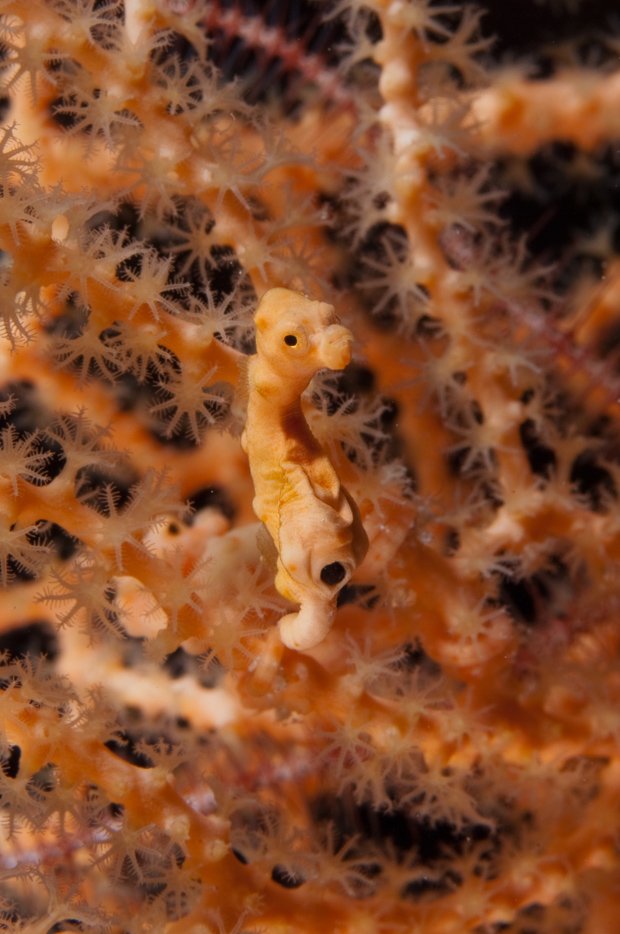GALLERY: Pygmy seahorses

Of the seven known species of pygmy seahorse, Bargibant’s (Hippocampus bargibanti) is one of the largest. They grow to a maximum of 2.7cm, which is less than the diameter of an Australian 20-cent coin.
Photo Credit: Richard Smith
There are seven species of pygmy seahorse in total. This Denise’s pygmy seahorse measured less than 2cm in length.
Photo Credit: Richard Smith
Pygmy seahorses, such as this Denise’s pygmy (Hippocampus denise), live on gorgonian coral, which are soft, bush-like colonies that thrive in the tropics and sub-tropics.
Photo Credit: Richard Smith
Walea soft coral pygmy seahorses (Hippocampus waleananus) weren’t described until 2009. They are found in only one small bay in Sulawesi, Indonesia where they live on certain species of beige soft coral. Almost nothing is known about their conservation status.
Photo Credit: Richard Smith
The pygmy seahorse’s camouflage is almost unequalled in the animal kingdom. A pygmy seahorse spends its first five days on the coral changing to perfectly match the colour and surface texture of its new home, where it will remain for the rest of its life.
Photo Credit: Richard Smith
The first pygmy seahorse to be discovered was Bargibant’s in 1970. A pair was found on a gorgonian collected by the Noumea Museum in New Caledonia. After a 30-year hiatus, another six species were described in the first decade of this millennium.
Photo Credit: Richard Smith
Pygmy seahorses are relatively social fish. Pairs conduct courtship dances at dawn and dusk to strengthen their bond. These dances take place before and after the fish retire, which they do in the same area of their gorgonian home each day.
Photo Credit: Richard Smith
Despite their size, pygmy seahorses are included within the same genus, Hippocampus, as their larger cousins. The whole group is afforded protection internationally and their trade is tightly regulated, although there remains a significant black market demand.
Photo Credit: Richard Smith
Pygmy seahorses can be quite active. They aren’t, however, very strong swimmers, relying only on a tiny dorsal fin, a pair of pectoral fins either side of the head and an even smaller fin at the base of the tail.
Photo Credit: Richard Smith
A diver photographs pygmy seahorses on a gorgonian coral in Indonesia. These diminutive fish are sensitive to the excessive use of bright flashes and great care must be taken when observing or photographing them.
Photo Credit: Richard Smith
Serving a similar function to rutting stags, male Denise’s pygmy seahorses show off their virility by grasping another male with their tail.
Photo Credit: Richard Smith
Bargibant’s and Denise’s pygmy seahorses are entirely dependent on healthy gorgonian corals. If their gorgonian home begins to die they soon disappear, most likely having succumbed to predation by other fishes that are able to see them much more easily.
Photo Credit: Richard Smith
Pontoh’s (Hippocampus pontohi) is a free-living species of pygmy seahorse that is not found in association with gorgonian corals like some of its relatives. Rather, they prefer to live among small patches of algae or hydroids, a fern-like relative of the jellyfish.
Photo Credit: Richard Smith
Another small fish from the reefs of Indonesia is the pygmy pipehorse (Kyonemichthys rumengani). It reaches a maximum length of less than 3cm, but is much more slender than the pygmy seahorses. Unsurprisingly, it eluded discovery until 2007.
Photo Credit: Richard Smith
Satomi’s pygmy seahorse (Hippocampus satomiae), described in 2008, is the world’s smallest pygmy seahorse, reaching a maximum length of 1.4cm. They are known only from Indonesia and have been seen by very few people. They are active at dusk, making them particularly difficult to observe.
Photo Credit: Richard Smith
The largest of all seahorses is the Pot-bellied, (Hippocampus abdominalis), which is found in southern Australia and New Zealand. The maximum recorded length of this species is 35cm and large males can give birth to over 1000 young.
Photo Credit: Richard Smith
Like all seahorses, it is the male pygmy that becomes pregnant and takes care of all post-fertilisation duties. Pygmy seahorses differ from their larger kin by brooding the young in a pouch located within the body cavity, rather than on the tail. This is believed to be an adaptation for their small size.
Photo Credit: Richard Smith
After a gestation period of 11-12 days the male Denise’s pygmy seahorse gives birth to up to 12 fully formed young, each measuring around 3mm. The young float away in water currents to be carried to a new gorgonian coral of their own.
Photo Credit: Richard Smith
The male’s brood pouch contains a network of veins, supplying the developing fry with nutrients and oxygen, as well as removing waste products.
Photo Credit: Richard Smith
After the young are released, the male pygmy seahorse is left deflated, exhausted and with stretch marks across the belly. There is no rest for the tiny fish, as he must return to his mate in order to receive a new clutch of eggs.
Photo Credit: Richard Smith
Just 30 minutes after giving birth, the male remates with his partner. The female (left), swollen with unfertilised eggs, pushes the whole clutch into the male’s pouch where they will be fertilised and brooded for the next 12 days.
Photo Credit: Richard Smith
The highest diversity of pygmy seahorses is in coral reefs in Indonesia, where six of the seven known species are found. However, these reefs are some of the most threatened in the world due to pollution, destructive fishing techniques and climate change.
Photo Credit: Richard Smith

